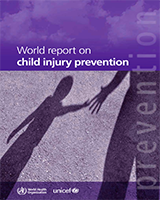BOX 5.3Product safety and falls from nursery furniture
Many countries have found injuries associated with nursery furniture to be an important issue in children under the age of five years. In the first year of a child’s life, these injuries may represent almost 20% of injuries treated in hospital (188). The introduction of injury surveillance systems and detailed systematic analyses of deaths in young children led, in the last two decades of the twentieth century, to a greater awareness in developed countries of injuries related to nursery furniture, including cots, baby walkers, high chairs, prams, pushchairs, baby bouncers and changing-tables (121).
While the overwhelming majority of non-fatal, hospital-treated injuries associated with nursery furniture are due to falls, the types of injury involving nursery furniture leading to deaths are more varied. Such injuries include suffocation and strangulation, as well as asphyxiation following a fall – for example, following the tipping over of a pram.
In 2002, the International Standardization Organization published guidelines for protecting children against injury from products (including buildings and installations), processes and services (189). These guidelines were aimed at those involved in setting or revising standards, as well as at designers, architects, manufacturers, service providers, communicators and policy-makers.
Several countries have established standards – usually voluntary but sometimes mandatory – for the most frequently-used nursery products. These product-specific standards are known as “vertical standards”. Mandatory vertical standards have been introduced in developed countries on a country-by-country basis, where voluntary measures have failed. The European Union has a Product Safety Directive that clearly sets out who is responsible for product safety at each stage – from design through manufacture, to importation, wholesale and retail of products.
Standards can also be based on the hazards, rather than the products, and these are known as “horizontal standards”. Australia, for instance, is in the process of introducing horizontal standards, following a review of the product safety system and the way in which standards were made.
Developing countries need now to adopt the best practices in product safety. Several developing countries already manufacture products for export, and follow safety standards set in the high-income countries importing the products. A horizontal approach to safety standards is often the most effective way to ensure safety for a wide range of existing, new and redesigned products.
